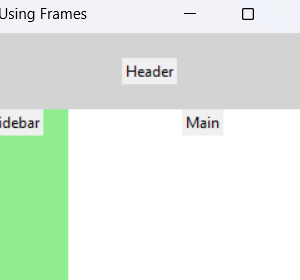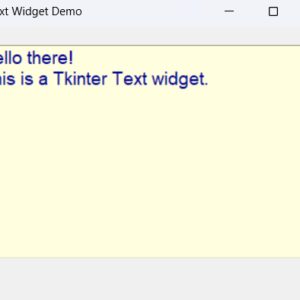Set Options for a Widget in Tkinter
Hey there!
So, you’re working with Tkinter Ttk widgets, and you want to tweak some options like text, images, fonts, whatever, right?
Well, good news—it’s easy!
There are three ways to do it, and I’ll show you all of them. 😎
Let’s dive in!
Set Options for a Widget in Tkinter
Contents
Why Do You Need To Set Options Anyway?
Well, imagine you’ve got a button or label, and you want it to say something cool like, “Hello, World!” or display an image or have a specific font style.
To make that happen, you need to set some options for your widgets.
And guess what? You’ve got three ways to do it:
- Using the widget constructor (when creating the widget).
- Using a dictionary index (after creating the widget).
- Using the
config()method (also after creating the widget).
Let’s break them down one by one.
1. Using the Widget Constructor (The Shortcut Method)
Alright, this is probably the easiest and most common way.
You just pass your options right when you’re creating the widget.
It’s like handing over a list of instructions from the get-go.
Example: Setting Text for a Label
Set Options for a Widget in Tkinter
import tkinter as tk
from tkinter import ttk
root = tk.Tk()
# Setting the text directly when creating the widget
ttk.Label(root, text='Hi, there!').pack()
root.mainloop()
📌 Output: You’ll see a label that says, “Hi, there!” right when you run your program. Quick and easy!
When to Use This:
When you know exactly what options you want to set upfront—like text, width, height, etc.
2. Using a Dictionary Index (After Creating the Widget)
Okay, so let’s say you’ve created a widget but totally forgot to set an option, or maybe you just want to change it later. This is where the dictionary index method comes in.
Example: Setting Text for a Label After Creation
import tkinter as tk
from tkinter import ttk
root = tk.Tk()
label = ttk.Label(root)
label['text'] = 'Hi, there!' # Setting the text using a dictionary index
label.pack()
root.mainloop()📌 Output: Same thing, a label with the text “Hi, there!” but you set the text after creating the label.
When to Use This:
Perfect for when you want to update or change a widget’s option dynamically during runtime.
Set Options for a Widget in Tkinter Set Options for a Widget in Tkinter
3. Using the config() Method (The All-Rounder Approach)
You can use it anytime, whether you’re creating the widget or adjusting it later.
Example: Setting Text for a Label Using config()
import tkinter as tk
from tkinter import ttk
root = tk.Tk()
label = ttk.Label(root)
label.config(text='Hi, there!') # Setting the text using config()
label.pack()
root.mainloop()📌 Output: Yup, another label saying “Hi, there!”—but you did it using config().
When to Use This:
When you’re working with multiple options at once or you want to keep your code looking clean and organized.
Which method is the fastest?
They’re all pretty quick, but using the constructor is generally the cleanest and most efficient if you know what you need from the start.
Conclusion
And that’s it!
Now you’ve got three easy ways to set options for your Tkinter Ttk widgets.
If you want me to show you how to apply these methods to other widgets like buttons, entries, or even CustomTkinter widgets—just give me a shout! 🚀
Happy coding! 😄
Set Options for a Widget in Tkinter Set Options for a Widget in Tkinter


